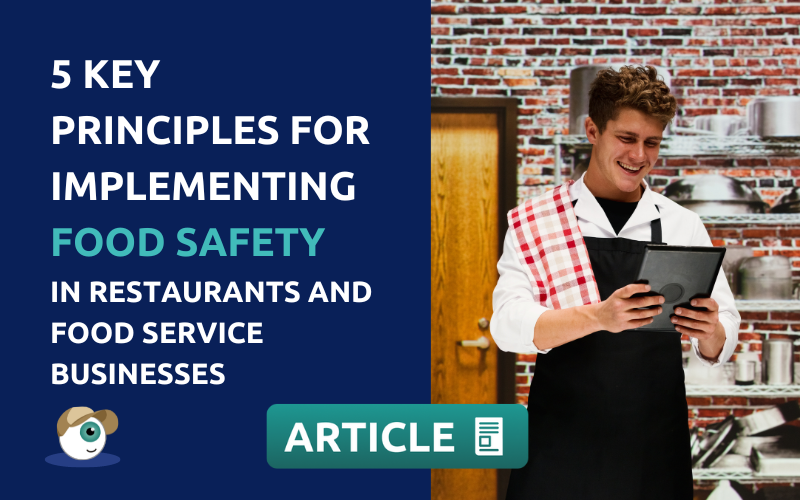5 Key Principles for Implementing Food Safety in Restaurants

In the hospitality and food service industries, ensuring impeccable food safety practices is not only a legal obligation but also crucial for the success and reputation of all types of businesses.
Implementing robust food safety measures not only protects customers from potential health hazards but also fosters a culture of trust and loyalty.
In this article, we will explore five key principles that are essential for implementing food safety in restaurants – from establishing a strong food safety culture to embracing technology like Andy’s automated solutions, these principles are the pillars of success for every food establishment.
Principle 1: Prioritise Basic Food Hygiene
Basic food hygiene practices form the foundation of a safe and hygienic restaurant environment.
This principle involves:
Proper Food Handling:
Ensuring that raw ingredients and cooked food are handled separately to prevent cross-contamination. Regular handwashing is emphasised to maintain hygiene.
Effective Food Storage
Adhering to appropriate temperature controls for perishable items to prevent bacterial growth. Clear labelling of food products with expiration dates is an essential component of food safety in restaurants.
Hygienic Food Preparation
Principle 2: Implementing HACCP for Advanced Food Safety in Restaurants
To take food safety to the next level is vital to successfully implement Hazard Analysis Critical Control Points (HACCP) protocols in your kitchen/s.
This involves:
Hazard Analysis
Conducting a comprehensive analysis to identify biological, chemical, and physical hazards in the food handling process.
Critical Control Points (CCPs)
Identifying specific points in the food production process where control is essential to prevent, eliminate, or reduce identified hazards.
Establishing Critical Limits
Setting maximum or minimum values that must be maintained at CCPs to ensure food safety.
Monitoring Procedures
Regularly monitoring CCPs to detect deviations from critical limits and take corrective actions.
Corrective Actions
Implementing immediate actions to bring the process back to intended conditions if CCPs are not under control.
Verification Procedures
Conducting internal audits and inspections to verify the effectiveness of the HACCP system.
Record-Keeping
Meticulously documenting all aspects of the HACCP system, including hazard analysis, CCPs, monitoring results, corrective actions, and verification activities.
Principle 3: Cultivating a Strong Food Safety Culture
A strong food safety culture is essential for embedding food safety practices into the DNA of a restaurant. This principle involves:
Leadership Commitment
Restaurant owners and managers must lead by example, demonstrating a commitment to food safety and holding all staff accountable.
Continuous Training
Providing comprehensive training in food safety practices for all employees, including new hires and existing staff.
Open Communication
Encouraging open communication between staff members to address any concerns or potential issues related to food safety.
Recognition and Incentives
Recognising and rewarding employees who consistently uphold food safety standards to reinforce a positive food safety culture.
Transparency and Learning
Promoting transparency in reporting incidents or near-misses and using these opportunities as learning experiences to prevent future occurrences.
Principle 4: Embracing Technology for Automation of Food Safety in Restaurants
In today’s digital era, technology plays a pivotal role in enhancing food safety practices:
Digital Hygiene Checklists
Leveraging digital checklists for tasks like cleaning, sanitisation, and equipment maintenance to ensure compliance and streamline operations.
Automated Reminders
Setting up automated reminders for hygiene tasks, inspections, and audits to prevent oversights and delays.
Incident Management
Utilising digital incident management tools to promptly report and address food safety incidents.
Food Traceability
Implementing digital food labelling tools to enhance traceability and transparency of ingredients from source to plate.
Principle 5: Continuous Improvement and Adaptability
Food safety is a dynamic field, and continuous improvement is key to staying ahead of emerging challenges.
This principle involves:
Learning from Incidents
Conducting thorough investigations of food safety incidents and using the insights to enhance prevention measures.
Feedback Mechanisms
Encouraging customers to provide feedback on food safety and using the insights to make necessary adjustments.
Regular Review of Procedures
Periodically reviewing food safety procedures and protocols to ensure they align with the latest best practices and regulations.
Collaboration and Industry Updates
Engaging with industry associations and staying informed about the latest trends and advancements in food safety.
Implementing food safety in restaurants is a multifaceted endeavor that requires a dedicated approach to basic hygiene, advanced methodologies like HACCP, fostering a robust food safety culture, embracing technology for automation, and maintaining a commitment to continuous improvement.
By adhering to these five key principles, restaurants and foodservice businesses can create a safe and trusted dining experience for their customers while ensuring compliance with food safety regulations.
With Andy’s automated solutions at their disposal, restaurants can further streamline their food safety practices, making the journey to impeccable food safety more accessible and efficient than ever before.
Try Andy now and discover the many benefits of having this helpful Food Safety digital assistant in your kitchens!
👉🏽START 100% FREE HERE!👈🏽

